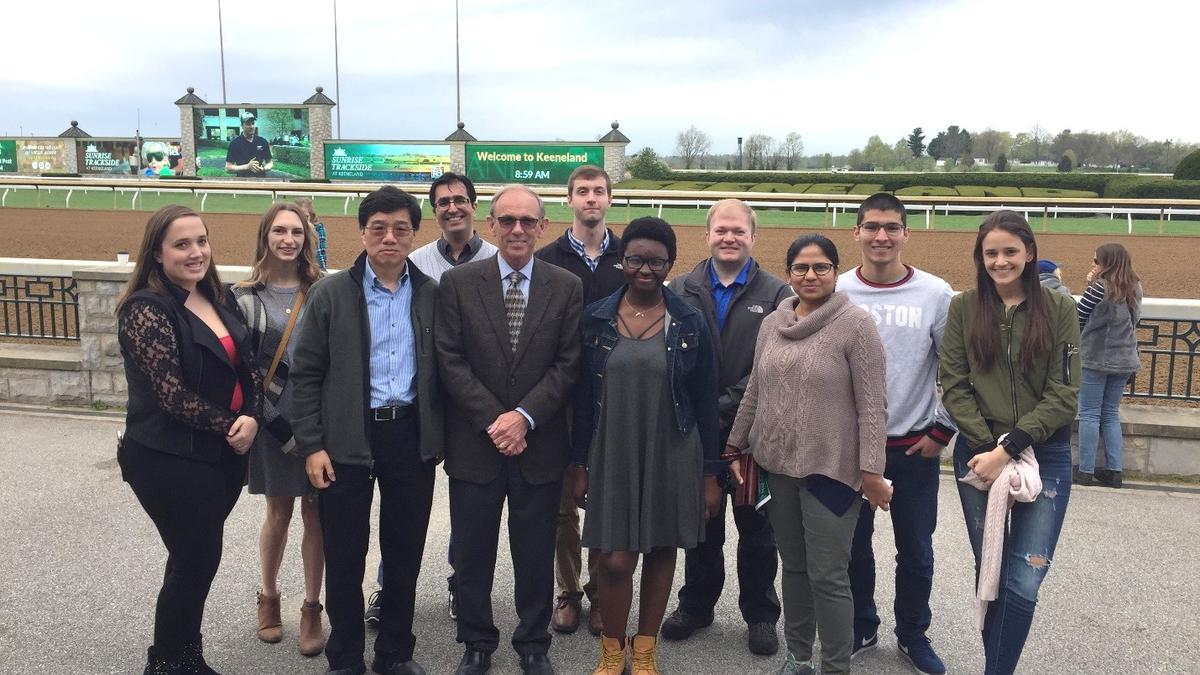By Matt Ballard, President of BMES Student Chapter at UK
Lexington is known as the “horse capitol of the world”, and it’s hard to find a better environment to witness these magnificent animals than at Keeneland Racecourse. Students in biomedical engineering (BME) at the University of Kentucky are making a habit of using this location to discuss how BME principles may be applied to the equestrian world.
The 2nd Annual Breakfast at Keeneland event took place on Saturday, April 13th, 2019. Students arrived before dawn to an unfamiliarly quiet concourse where the only sounds to be heard were hooves plodding on the track and the occasional excited nickering of a horse. The event was organized by the Biomedical Engineering Society (BMES) student chapter at UK. Nine students (Megan Gilliam, Kayla Danicki, Abby Olaleye, Susana Carrizosa-Botero, Felipe Duque, Dibyajyoti Biswal, Siavash Mazdeyasna, Chase Haddix, and Matt Ballard) and two faculty members (Dr. David Pienkowski and Dr. Guigen Zhang) attended the event. This year, the event featured Dr. David Lambert of Equine Analysis Systems as the invited speaker for a roundtable discussion.
Over breakfast, Dr. Lambert shared information about his background and the founding of his company. He gave examples of how his life experiences from growing up in rural England gave him different perspectives, which led to unique methods of problem solving. For years, people had evaluated and examined horses by comparing them to what was known about the human body, physiologically speaking. Dr. Lambert explained how this method was inappropriate given differences in how a horse’s body works compared to a human. For example, while a horse is running a race it is only able to inhale while the front legs are off the ground, which is a very short period of time. This means the horse must be able to acquire oxygen from other sources. Dr. Lambert went on to detail how he used his knowledge in equine physiology to provide a more holistic approach to horse evaluations. Much like a basketball player may need exceptional height or arm length (wingspan) to play at the University of Kentucky, certain physical traits are needed for a horse to perform at the highest level. Dr. Lambert has developed a novel method of determining which horses are likely to develop these traits while they are still young.
Dr. Lambert further provided students with some ideas of biomedical engineering problems that may be impacting the future of the horse industry such as injury prevention. The latest Kentucky Derby, in which a horse was disqualified for the first time in the history of the event for actions that endangered other horses, is a prime example of the importance of horse and rider safety. Dr. Lambert encouraged students that as they begin the task of solving these problems (and others), it is often not enough to just think like an engineer. Individuals will need to think creatively and approach problems from a new direction. Instead of focusing on just the horse, perhaps examining the situation with relation to the rider or the track could present new solutions.
After the event, Dr. Lambert expressed his appreciation for being invited and was hopeful that further interactions with students could occur. The event was also a big hit with students, with one describing how interesting it was to learn about the differences between horses and other animals that they were not aware of before. Another student claimed it was “an amazing reminder to not get caught up in the grind but to go out and get inspired by something.”
“I was unaware of the exposure I could get from this event. The discussions were mainly based on the past, present and possible future application of Biomedical Engineering in Equine research. We got to learn the perspective of some of the researchers who have dedicated their life to this research. Discussing research over breakfast, while having a great view of the sunrise at beautiful Keeneland, I couldn't have asked for more.”
“Breakfast at Keeneland was an entertaining and educational event organized by UK BMES. Dr. David Lambert was the invited guest, he gave us a unique talk about equine analysis. His talk elucidated some perspective about horses during a race. It was fascinating to learn that horses take in one breath for every stride they make while galloping or that a spring-like (i.e., elastic) lower body plays a vital role in the equine movement. The take home for me was that it is critical to have comprehensive knowledge about the problem/system before trying to assess the impact.”
These are signs that for BME students in the F. Joseph Halcomb III, M.D. Department of Biomedical Engineering, learning happens not just inside classrooms, it occurs even during such fun times. According to Dr. Zhang, he first met Dr. Lambert about two months after his arrival at UK in 2017, after Dr. Zhang gave a seminar on bone biomechanics in the Gluck Equine Center. Because of their common belief that biomedical and animal research needs to be done in holistic ways, they have become close friends since. When Dr. Zhang visited Equine Analysis Systems a few months after their first encounter, he was impressed by the integrative approaches Dr. Lambert and his team use in assessing the running performances of horses. From that point on, he knew that he would someday invite Dr. Lambert to meet the students in the BME department so they could learn some important wisdom from him.
The BME students seek out unique opportunities to enhance learning in the field of biomedical engineering such as Breakfast at Keeneland and others. To get involved in BME or with the UK student chapter of BMES, send an email to ukybmes@gmail.com.
